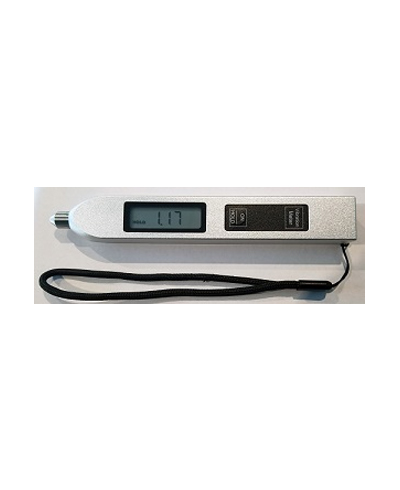Pocket Vibration Meters/Pen Type Vibration Meters/Vibration Meters
Model No. DVM-0500/0600
Features
DVM-0600 Inch Vibration Pen:
Phase II now brings the latest state-of-the-art pocket vibration meters into our ever expanding product line of testing instrumentation.
The DVM-0500 and DVM-0600 pocket vibration meters utilize the singular velocity parameter, making testing easy. A full frequency range is available for broad detection abilities.
These Phase II pocket vibration meters are designed to aid in the preventive maintenance of machinery, bearings, or any other object in motion by picking up vibration changes over time.
DVM-0500 Metric Vibration Pen
Useful features of the DVM-0500 and DVM-0600 vibration meters include last value hold and auto shut off.
Simply a must have for maintenance personnel.
DVM-0500 and DVM-0600 comes complete with certificate of calibration, operation manual and carry case.
Specifications:
| Measuring Range | RMS Vibration velocity 0.1mm/s to 199.9 mm/s 0-19.99 inch/s |
|---|---|
| Frequency Range | 10Hz to 1000Hz |
| Display | 3.5 digit LCD |
| Accelerometer | Integrated |
| Power Supply | 1.5v button cell batteries (2) NiCad Rechargeable |
| Operating Temp | 0-40°C <86%RH |
| Dimensions | 150 X 22 X 18mm |
| Weight | 55g |
Vibration measurement notations:
Before taking a vibration measurement, you need to attach a sensor that can detect vibration behavior to the machine that is being measured. Various types of vibration sensors are available, but a type called accelerometer is normally used as it offers advantages over other sensors. An accelerometer is a sensor that produces an electrical signal that is proportional to the acceleration of the vibrating component to which the accelerometer is attached.
What is the acceleration of a vibrating component? It is a measure of how quickly the velocity of the component is changing.
The acceleration signal produced by the accelerometer is passed on to the instrument that in turn converts the signal to a velocity signal. Depending on the user’s choice, the signal can be displayed as either a velocity waveform or a velocity spectrum. A velocity spectrum is derived from a velocity waveform by means of a mathematical calculation known as the Fast Fourier Transform or FFT.
Most machines involve rotary mechanisms. Motors, pumps, compressors, fans, belt conveyors, gearboxes, all involve rotary mechanisms and are frequently used in machines.
Most rotary mechanisms in turn have bearings that support the weight of rotating parts and bear the forces associated with rotary motion and vibration. In general, large amounts of force are borne by bearings. It is not surprising that bearings are often the place where damage occurs and where symptoms first develop.
Vibration measurements are thus usually taken at the bearings of machines, with accelerometers mounted at or near the bearings.
Since conclusions regarding machine condition – and hence whether or not money and human safety are risked – depend on the accuracy of measurements, we must be very careful how measurements are taken. It is important to always remember that the way in which we mount the accelerometer very much determines the accuracy of measurements.
How should accelerometers be mounted to ensure measurements are accurate and how can we do so safely? Here are some guidelines:
Mount as Close as Possible to the Bearing
Imagine a doctor who listened to your heart through thick clothing and placed the stethoscope closer to your kidney than to your heart. You would likely doubt his diagnosis as he would be basing it on sounds distorted by undue obstruction and noise from other organs.
For the accelerometer to detect true vibration behavior, it needs to undergo exactly the same vibratory movement as the vibrating component. An accelerometer must therefore be attached firmly to the vibrating component so that it does not rock or move independently of the component. A loosely mounted accelerometer produces signals distorted by its own independent movements and therefore gives the wrong message.
What are measurement parameters?
Measurement parameters are the details that specify how a measurement is to be taken. By specifying measurement parameters, we specify how data is to be collected and processed before it is presented to us. Before taking a vibration measurement we need to specify what parameters will be used.
The parameters for vibration measurement may be likened to the ‘what and how’ details that a doctor must specify before a medical test is performed.


